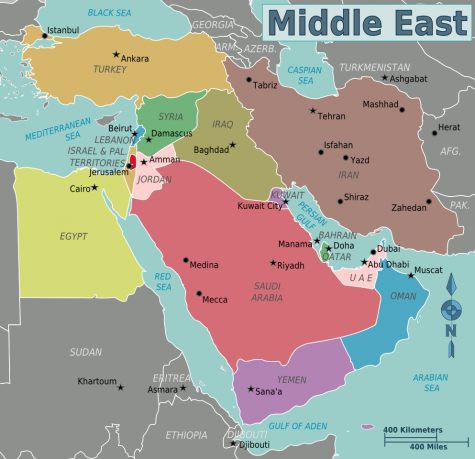What’s Goin’ on with Iran?
Iran-U.S. tensions, World War III, and other worries explained
Among many unfortunate events that seemed to usher in the new decade, the situation foremost in Americans’ minds was the assassination of Qasem Soleimani and the following turmoil between the United States and Iran. For teens especially, there has been a lot of stress about global tensions and the possibility of war. Many relieved this stress in the main way that teens do: by making a wave of memes about being drafted into World War III. But what really happened and what does this mean for the future? I’m here to explain.
The series of recent developments between Iran and the U.S. all began with the assassination of General Qasem Soleimani on Jan. 3. According to CNN, Soleimani was the leader of the Revolutionary Guards’ Quds Force, which is an elite Iranian military unit and is also designated as a foreign terrorist organization by the U.S. Soleimani and a few others were killed by a drone strike in Baghdad, Iraq. The United States has maintained thousands of troops in Iraq and many other Middle Eastern neighbors of Iran for years, which is why the attack took place in Iraq rather than Iran.

The immediate result of Soleimani’s death was a promise of retaliation from the president of Iran, and criticism from the U.S. Congress, which had not been informed of the strike prior to its execution. On Jan. 6, confusion arose when the U.S. military sent a letter to Iraqi officials that implied the removal of troops from Iraq, when no decision was actually made to leave. The delivery of the letter was alleged to be a mistake by the Trump administration, but military leadership may have just disagreed about sending it. This letter, according to the Washington Post, encouraged Iraq’s parliament to make a call for the departure of American troops, and if the parliament and prime minister agree to rescind permission for the American forces stationed in Iraq, the United States would have to either remove the troops or illegally occupy Iraq. No such vote has been made, but it remains possible.
Tensions between the U.S. and Iran grew on Jan. 6, as President Trump wrote in a series of tweets that the United States had targeted 52 sites of cultural importance to Iran to be attacked if Iran took action against America or its assets. Quickly, the Secretary of State, Defense Secretary, and other members of Trump’s administration rejected the threat, which if acted upon would be considered an international war crime. NPR reported that purposefully targeting cultural sites would violate the agreement made by the United States in the 1954 Hague Convention to refrain from hostility towards cultural property.
The revenge promised by Iran’s leadership took place on Jan. 7, as Iran launched missiles at two military bases in Iraq. The Pentagon reported that there were no deaths, and few injuries due to the attacks, but the heaviest damage to lives happened elsewhere that day. In Soleimani’s hometown, Kerman, thousands gathered to attend a burial service for the influential general. During this event, the crowded streets erupted into a stampede that killed 50 and injured over 200 more mourners, according to BBC news. The funeral crowd was also reported as chanting “death to Trump” that morning before the strike on U.S. and Iraqi military bases. Another loss that day came from the crash of a Ukrainian plane and the deaths of all 176 people on board including Iranian and Canadian families. Later, it became clear that the missiles launched at the Iraqi bases by Iran that night were responsible for the crash, and the president of Iran publicly apologized for the mistake.
Since then, there have not been many further developments with Iran. Although the memes are still going strong, it seems that this conflict will not develop into a war, especially not a worldwide conflict. In the event of a future war, there is also not much to fear about a draft, which has not been issued since the Vietnam War because it is not a well-supported measure. Some issues remain unresolved, such as the unpopular presence of United States troops across the Middle East and the civil unrest in Iran, but for now, this is where the situation stands.
For further reading and sources, see the articles below:
https://www.cnn.com/2020/01/03/asia/soleimani-profile-intl-hnk/index.html -CNN, “Who was Qasem Soleimani, the Iranian commander killed by a US airstrike?”
https://www.bbc.com/news/world-middle-east-51015795 -BBC, “Qasem Soleimani: Stampede kills 50 mourners at burial in Iran”
https://www.npr.org/2020/01/06/794006073/trump-says-hell-target-iran-s-cultural-sites-that-s-illegal -NPR, “Trump Says He’ll Target Iran’s Cultural Sites. That’s Illegal”
https://www.nytimes.com/2019/10/21/world/middleeast/us-troops-deployments.html -New York Times, “Despite Vow to End ‘Endless Wars,’ Here’s Where About 200,000 Troops Remain”
https://www.newsweek.com/where-us-troops-near-iran-1480617 -Newsweek, “Where Are U.S. Troops Near Iran? Tens of Thousands of American Soldiers Are in Middle East, Afghanistan”
https://www.washingtonpost.com/world/middle_east/iran-live-updates/2020/01/07/896c70a2-30d5-11ea-9313-6cba89b1b9fb_story.html -Washington Post, “More than a dozen missiles hit two bases in Iraq, Pentagon says”
https://www.washingtonpost.com/world/getting-us-troops-out-of-iraq-might-not-be-that-hard-say-experts/2020/01/06/9f64060c-3069-11ea-898f-eb846b7e9feb_story.html -Washington Post, “Getting U.S. troops out of Iraq might not be that hard, say experts”






